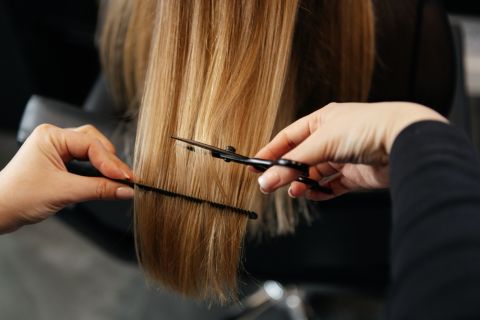ALBAWABA Achieving and maintaining healthy hair requires a consistent hair care routine tailored to your hair type and needs. A good routine can help prevent damage, promote growth, and keep your hair looking its best.
Here are essential steps to incorporate into your hair care regimen for healthy, vibrant hair.
1. Know Your Hair Type
Before starting any hair care routine, it's crucial to understand your hair type. Hair can be straight, wavy, curly, or coily, and each type has different needs. Additionally, hair can be fine, medium, or thick, and it can be dry, oily, or a combination. Knowing your hair type will help you choose the right products and treatments.
2. Gentle Cleansing
Regular cleansing is essential to remove dirt, oil, and product buildup from your scalp and hair. However, over-washing can strip your hair of its natural oils, leading to dryness and breakage. Here's how to cleanse your hair effectively:
- Choose the Right Shampoo: Use a sulfate-free shampoo that matches your hair type. Sulfates can be harsh and drying, especially for curly or dry hair. A gentle shampoo will clean your hair without stripping it of moisture.
- Frequency: The frequency of washing depends on your hair type. Oily hair may need to be washed more frequently (every 1-2 days), while dry or curly hair may only need washing once or twice a week.
- Scalp Care: Focus on massaging your scalp while shampooing to stimulate blood flow and remove any buildup. Avoid piling your hair on top of your head when washing, as this can cause tangling.
3. Conditioning
Conditioning is crucial for adding moisture back to your hair and improving its texture and manageability. After shampooing, apply a conditioner that suits your hair type:
- Conditioner Application: Apply conditioner mainly to the mid-lengths and ends of your hair, where it tends to be drier. Avoid applying too much conditioner to the scalp, as this can lead to oiliness.
- Deep Conditioning: Once a week, use a deep conditioning treatment or hair mask to provide intense hydration and repair any damage. Leave the treatment on for the recommended time, usually 10-20 minutes, before rinsing thoroughly.
4. Detangling
Proper detangling is key to preventing breakage and keeping your hair healthy:
- Use the Right Tools: Use a wide-tooth comb or a detangling brush to gently work through knots and tangles. Start from the ends of your hair and gradually work your way up to the roots.
- Detangling Products: Consider using a leave-in conditioner or detangling spray to make the process easier, especially if you have curly or thick hair.
5. Moisturizing and Sealing
Moisturizing your hair helps to maintain its hydration, while sealing locks in the moisture to keep your hair soft and healthy:
- Leave-In Conditioner: After washing and conditioning, apply a leave-in conditioner to damp hair. This provides extra moisture and protection throughout the day.
- Hair Oils and Serums: For added moisture and shine, apply a lightweight hair oil or serum to the ends of your hair. Oils like argan, coconut, or jojoba are excellent for sealing in moisture and preventing split ends.
6. Protective Styling
Protective styling helps to minimize damage and breakage by reducing the amount of manipulation your hair undergoes:
- Low-Manipulation Styles: Hairstyles like braids, buns, or twists reduce the need for daily styling and help protect the ends of your hair from breakage.
- Night Protection: Use a silk or satin pillowcase, or wrap your hair in a silk or satin scarf before bed to reduce friction and prevent breakage. This is especially important for curly or textured hair.
7. Heat Protection
Excessive heat styling can cause damage and weaken your hair over time. If you use heat tools like straighteners, curling irons, or blow dryers, it's essential to protect your hair:
- Heat Protectant: Always apply a heat protectant spray or serum before using any heat tools. This creates a barrier that helps reduce damage from high temperatures.
- Lower Heat Settings: Use the lowest heat setting necessary to achieve your desired style, and try to limit the use of heat tools to avoid cumulative damage.
8. Regular Trimming
Regular trims are essential for maintaining healthy hair. Trimming removes split ends, which can travel up the hair shaft and cause more significant damage:
- Frequency: Trim your hair every 6-8 weeks to keep it healthy and prevent split ends. If you're trying to grow your hair, you can extend this to every 10-12 weeks, but be mindful of split ends.
9. Balanced Diet and Hydration
Healthy hair starts from within, so it’s important to maintain a balanced diet rich in vitamins and minerals that support hair growth:
- Nutrition: Include foods rich in biotin, vitamins A, C, D, and E, iron, and omega-3 fatty acids in your diet. These nutrients help strengthen hair and promote growth.
- Hydration: Drink plenty of water to keep your hair hydrated from the inside out. Proper hydration helps maintain the moisture balance in your hair, making it less prone to dryness and breakage.
A consistent hair care routine tailored to your hair type and needs is key to achieving and maintaining healthy hair. By following these steps—cleansing, conditioning, moisturizing, protecting, and nourishing your hair—you can ensure your hair stays strong, shiny, and healthy. Remember that patience and consistency are vital, as healthy hair care is an ongoing process.








